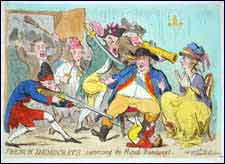 |
| |
| |
|
An Interpretive Study of Prints on the |
||||||||
“Memorable Day at Versailles” [Image 6] is a color print, most likely the copy of an earlier version entitled, “The Triumphal Return of the French Heroines from Versailles to Paris, 6 October, 1789” [Image 32] done by, or in the manner of, Debucourt.12 In the present version, the anonymous artist has added a male Jacobin and a woman dressed in sans-culotte attire to the Debucourt original. The crude primary colors in the current print indicate a rough, inexpensive form of production, perhaps a metal or wood-block etching colored with stenciled applications. The vibrant red of the rider's jacket, the phrygian cap, and the carmagnole vest of the figure in the background, plus the red skirt and frippery of the women's dresses indicate that republican colors and symbols could have been added subsequently (after 1792) to the earlier engraving. Thus, the composition provides a jibe toward both the market women who march on Versailles in 1789 and the sans-culottes women who, in the absence of the king, continue to pursue their own sexual and political exploits. This burlesque shift in power from king to courtesans certainly questions the credibility of the sans-culotte revolution. Cartoonists, such as James Gillray, also used bitter satire to discredit the French revolution among curious Brits. The explosion of British cartoons after 1792 reveals the extent of the political threat posed across the channel. 13 In one such print, “French Liberty, British Slavery,” [Image 23] Gillray points out the frenzied madness of French revolutionaries as compared with the opulence and prosperity of John Bull, who, at the time of the revolution, represents characteristics of the ordinary British citizen. 14 The artist presents “Liberty” personified as an emaciated bohemian seated on a stool, eating turnips and greens (animal fodder) in front of a smoking fireplace. The surrounding room is stark with a cobweb in one corner of the window and a basket of turnips on the table. A sword lies atop a violin, suggesting Liberty's relinquishment of aesthetic skills for martial pursuits. Strangely, Liberty wears the torn stockings and the culottes of a former notable or aristocrat rather than the trousers of an artisan or laborer. But the face of the French radical registers the angularity, length, and obsessed expression of unequivocal hunger. His long hair tied with a bow and bright cockade on his hat identify the starving figure as a desperate proponent of the revolution, but his clawed hands and feet suggest a closer affiliation with the animal world than with the human. Epithets in the balloon above his head laud Liberty in a series of unrelated phrases such as, “Vive l' Assemblée Nationale,” “No more Taxes,” “No more slavery,” “All Free Citizens,” and “Ve svim in Milk and Honey.” Such empty phrases reveal how Gillray endeavors to discredit utopian platitudes about the French revolution.15
Gillray's effeminate
representation of “Liberty” in
his pink jacket contrasts sharply with the bald and obese figure
of “John Bull” dressed in royal blue, who is about
to ingest his proverbial pot roast and ale on the table in front
of him. The body and facial coloring of the flushed “Brit” reflect
the slab of beef he is about to devour. To give full attention
to his meal, the rotund gourmand has drawn the tablecloth around
his neck as an erstwhile bib and discarded his wig on the side
of the armchair. The legend in the balloon above his head reveals
his frustration with the taxation policies of the Pitt ministry. “This
cursed Ministry. They'll ruin us all with their damned taxes.” The
contrast between the starving French fiend and the prosperous British
glutton underlines the dearth and scarcity of material means in
revolutionary Gillray produces another vivid
caricature of revolutionary Notes 12 Jean Adhémar, Graphic Art in the 18th Century (New York, Toronto, London: McGraw Hill, 1964) 173-174: Highly influenced by the theories of Lavater who maintained a natural correspondence between physiognomy and moral character, Debucourt conveyed his message through facial types, expressions, and suggestive poses that he emphasized in his paintings and prints. The current print imitates the element of sexual intrigue apparent in Debucourt's earlier engraving, but does not duplicate the more ornate and effete rococo style. 13 Tamara
L. Hunt, Defining John Bull: Political Caricature and National
Identity in Late Georgian England (Cornwall, England: Ashgate
Books, 2003) 149: In order to divert British discontent in
the 1790's due to excessive tight purse strings and additional
taxes, “supporters of the status quo undertook propaganda
efforts to convince the lower and middle classes that it was
in their own best interests to remain loyal to the state, even
if their burdens and sacrifices seemed unreasonable. This helped
fuel an explosion of prints featuring John Bull . . . .” While
30 prints about John Bull were produced from 1784 to 1792,
they tripled after the republican revolution in 14 Adhémar, Graphic
Art in the 18th Century, 94: James
Gillray distinguished himself as a skilled draftsman and
observer of human foibles. He developed satirical cartoons
about the royal family in 15 Ibid., 160. Page 1 | 2 | 3 | 4 | 5 |
||||||||
|
A project of the Center for History & New Media, George Mason University and the Department of History, University of California, Los Angeles for the American Historical Review. |
||||||||




![Image 32. Le Retour triomphant des Héroïnes Françaises de Versailles à Paris le 6 Octobre 1789. [The Triumphant Return of the French Heroines from Versailles to Paris, October 6, 1789]](../images/32-retourlayer.jpg)
